 W
WBaba Shivo is a folk deity, worshiped in the northern states of India especially in Jammu & Kashmir and Himachal Pradesh. He is a warrior-hero, venerated as a saint and a Rudra Ansh avatar of Shiva. He is referenced in the folklore of Jammu. Little historical knowledge of him exists other than that he was son of Raja Ladh dev aka Raja Ladhha and Queen Kalavati aka Rani Kalli.
 W
WBahuchara Mata is a Hindu goddess of chastity and fertility in her Maiden aspect, of the incarnation of the Hinglaj. Like other divinities in Gujarat and Rajasthan, Bahuchara is of Charan origin. Devi Bahuchara was the daughter of Bapaldanji Detha. She is also considered the patroness of the hijra community. Her primary temple is located in Becharaji town in Mehsana district of Gujarat, India.
 W
WBanai, also known as Banu and Banu-bai, is a Hindu goddess and the second wife of Khandoba, a form of the god Shiva worshipped in the Deccan – predominantly in the Indian states of Maharashtra and Karnataka. Khandoba is portrayed as a king of Jejuri, where his chief temple stands. Some traditions do not give her the status of a legal wife and treat her as a concubine of Khandoba.
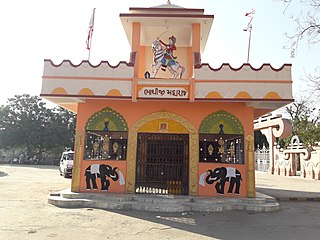 W
WBhathiji also called Bhathiji Maharaj is a folk deity of Gujarat. He is an eminent warrior-hero of the region.
 W
WGaninath also called Baba Ganinath and Baba Ganinath Ji Maharaj was a Hindu saint and a folk deity, who is worshipped as Kuldevta or Kulguru of Halwai and Kanu community in India. His worshippers regard him as an avatar of Lord Shiva. A postage stamp was issued to commemorate him in 2018 by the Department of Post, Government of India.
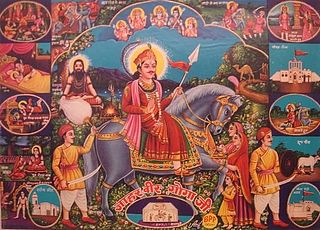 W
WGogaji is a folk deity, worshipped in the northern states of India especially in Rajasthan, Himachal Pradesh, Haryana, Uttarakhand, Punjab region, Uttar Pradesh, Jammu and Gujarat. He is a warrior-hero of the region, venerated as a saint and a 'snake-god'.
 W
WGolu Devta is the God of the Kumaon region of Uttarakhand state of India and is their deity.
 W
WHarsidhhi, one of the aspects of Durga is a regional Hindu goddess, popular in Gujarat, Madhya Pradesh, adjoining Maharashtra states of India.
 W
WIravan also known as Iravat and Iravant, is a minor character from the Hindu epic Mahabharata. The son of Pandava prince Arjuna and the Naga princess Ulupi, Iravan is the central deity of the tradition of Kuttandavar which is also the name commonly given to him in that tradition—and plays a major role in the tradition of Draupadi. Both these cults are of Tamil origin, from a region of the country where he is worshipped as a village deity and is known as Aravan. He is also a patron god of well-known transgender communities called ThiruNangai.
 W
WJakh Botera, Jakhdada, Jakkha Bautera, 72 Yaksha or Bohter Yaksha, literally seventy-two Yaksha warriors, are group of folk deities worshiped widely in Kutch district of Gujarat, India.
 W
WGuru Jambheshwar, also known as Guru Jambhaji, (1451-1536) was the founder of the Bishnoi Panth. He taught that God is a divine power that is everywhere. He also taught to protect plants and animals as they are important in order to peacefully co-exist with nature.
 W
WRana Jashraj was elevated to the name Veer Dada Jashraj and he was worshiped as kuladevata by the Lohana caste. In memory of Jashraj, Vasant Panchami is celebrated as a Shahid din of Veer Dada Jashraj.
 W
WA folkloric hero among the sect of Daryapanthi Sindhis, Jhulelal has been manufactured to be the most revered deity of Sindhi Hindus in postcolonial South Asia.
 W
WJvarasura also called Jwarasura in Hindu mythology is the fever-deity and the servant of the pox-deity goddess, Shitala.
 W
WKaruppu Sami is one of the regional Tamil male deities popular among the rural social groups of Tamil Nadu and parts of Kerala. He is one of the 21 associated folk-deities of Ayyanar and is hence one among the demi gods or Kaval Deivams of the Tamil heritage. He was believed to come from the South region (Madurai) as an assistant to Ayyanar during the Sangam Age. He was a local hero and then after his passing, the locals eventually worshipped his spirit and he was elevated as a "kaval deivam", just like Ayyanar was.According to some Ramayana book Karuppa was Kush Prince(son of king Rama).But Shaivaties believs that he is form of god Shiva and Vaishnavities believes that he is a form of god Vishnu.
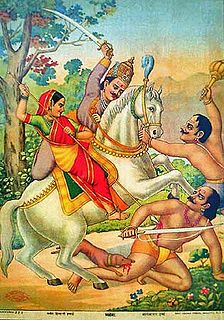 W
WKhandoba, Martanda Bhairava, Malhari, or Malhar is a Hindu deity worshiped as a manifestation of Shiva mainly in the Deccan plateau of India, especially in the state of Maharashtra and North Karnataka. He is the most popular Kuladaivat in Maharashtra and North Karnataka. He is also the patron deity of select warrior, farming castes, Dhangar community and Brahmin (priestly) castes as well as several of the hunter/gatherer tribes that are native to the hills and forests of this region. The sect of Khandoba has linkages with Hindu and Jain traditions, and also assimilates all communities irrespective of caste, including Muslims. The character of Khandoba developed during the 9th and 10th centuries from a folk deity into a composite god possessing the attributes of Shiva, Bhairava, Surya and Kartikeya (Skanda). He is depicted either in the form of a linga, or as an image of a warrior riding on a bull or a horse. The foremost centre of Khandoba worship is Jejuri in Maharashtra. The legends of Khandoba, found in the text Malhari Mahatmya and also narrated in folk songs, revolve around his victory over demons Mani-malla and his marriages.
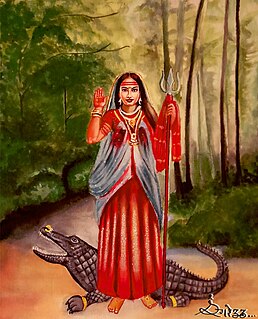 W
WKhodiyar is a Hindu folk goddess worshiped in Gujarat and Rajasthan states in India. The suffix Mata or Maa is generally added to her name, similar to other Hindu goddesses.
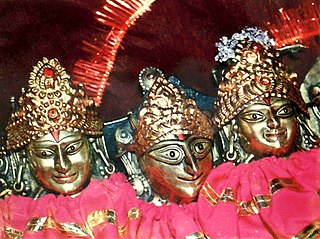 W
WShoolini, is the principal form of the Goddess Durga or Parvati, also known as Devi and Shakti.
 W
WMadurai Veeran, also known as Veeran is a Tamil folk deity popular in southern Tamil Nadu, India. His name was derived as a result of his association with the city of Madurai as a protector of the city. He is widely worshipped as a Great hero of the people.
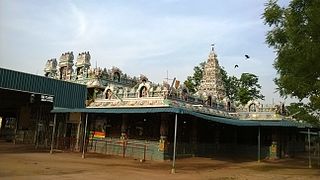 W
WMaisamma, also known as Mesai and additionally spelt Mesko, Amma in Telugu or Aai in Marathi is a Hindu folk goddess. She is mainly worshipped as a South Indian mother goddess, predominantly in the rural areas of Telangana, Karnataka and Maharashtra. Her worship is mainly associated with curing diseases such as smallpox and chickenpox.
 W
WManasa is a Hindu goddess of snakes, worshipped mainly in Bengal, Jharkhand, other parts of northeastern India and in Uttarakhand chiefly for the prevention and cure of snakebite and also for fertility and prosperity. Manasa is the mother of Astika, sister of Vasuki—king of Nāgas (snakes)—and wife of sage Jaratkaru. She is also known as Vishahara, Nityā (eternal) and Padmavati.
 W
WBaba Maneknath was 15th century legendary Hindu saint who lived on the banks of Sabarmati river near present city of Ahmedabad, Gujarat, India.
 W
WMuniandi is a regional Tamil guardian deity. The deity Muniandi refers to the Munis worshipped by the Tamil people in India, Malaysia and Sri Lanka.
 W
WOladevi is the goddess of cholera and is worshipped by people in the region of Bengal and Marwar. The goddess is also known as Olaichandi, Olabibi and Bibima. She is venerated by Hindus and Muslims of Bengal.
 W
WOm Banna is a shrine located in Pali district near Jodhpur, India, devoted to a deity. called Om Banna. It is located 20 kilometres (12 mi) from Pali and 53 kilometres (33 mi) away from Jodphur on the Pali-Jodhpur highway, near Chotila village. The motorcycle is a 350cc Royal Enfield Bullet RNJ 7773.
 W
WSantoshi Mata or Santoshi Maa is a Goddess in the Hindu folklore. She is venerated as "the Mother of Satisfaction", the meaning of her name. Santoshi Mata is particularly worshipped by women of North India. A vrata called the Santoshi Maa vrata performed by women on 16 consecutive Fridays wins the Goddess' favour.
 W
WThe temple of Maa Sheetla Chaukiya Devi is quite old. The worship of Shiva and Shakti happens here.
 W
WSheetala, also called Shitala, is a Hindu goddess widely worshiped in the Indian subcontinent, notably in North India. As an incarnation of Supreme Goddess parvati, she cures poxes, sores, ghouls, pustules and diseases, and most directly linked with the disease Smallpox acclaimed by Hindus. Goddess Shitala is worshiped on the eighth day after festival of colors (Holi), on the occasion of Sheetala Asthami.
 W
WDinman Hardoul Singh or Lala Hardoul is a Hindu folk deity of Bundelkhand in India. He was the prince of Orchha and the son of maharaja Vir Singh Deo and the brother of Jhujhar Singh. He was born in 1664 and died in 1688 at the age of 24. A temple of Hardoul in Bundelkhand is a centre for pilgrims and according to local beliefs he is still alive and is worshipped as a deity.
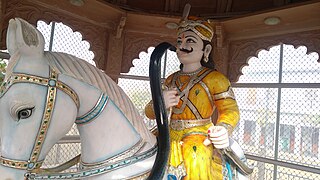 W
WVeer Teja or Tejaji is a Rajasthani folk deity. He is considered one of the major eleven incarnations of Shiva and worshipped as a deity in rural Rajasthan.
 W
WVachara Dada, also spelled as Vachhra Dada or Vasra Dada, also known as Vachchhraj Dada or Vatsaraj is a folk deity of Gujarat state in India. He is an eminent warrior-hero of the region. Hindus and Muslims alike honor him.